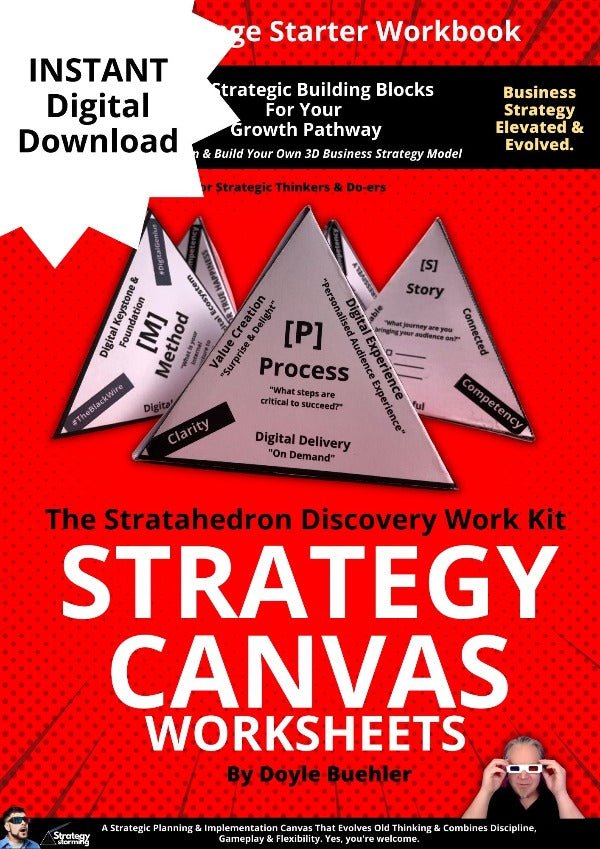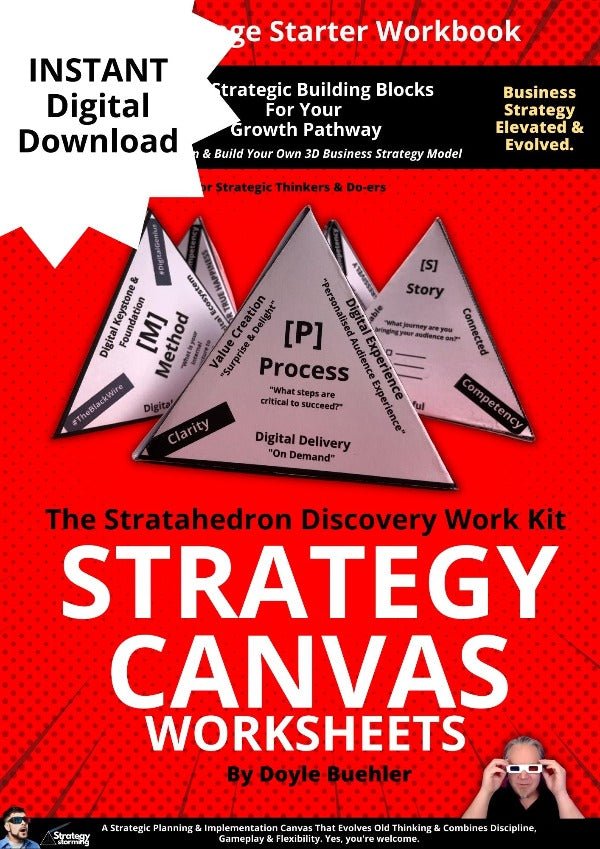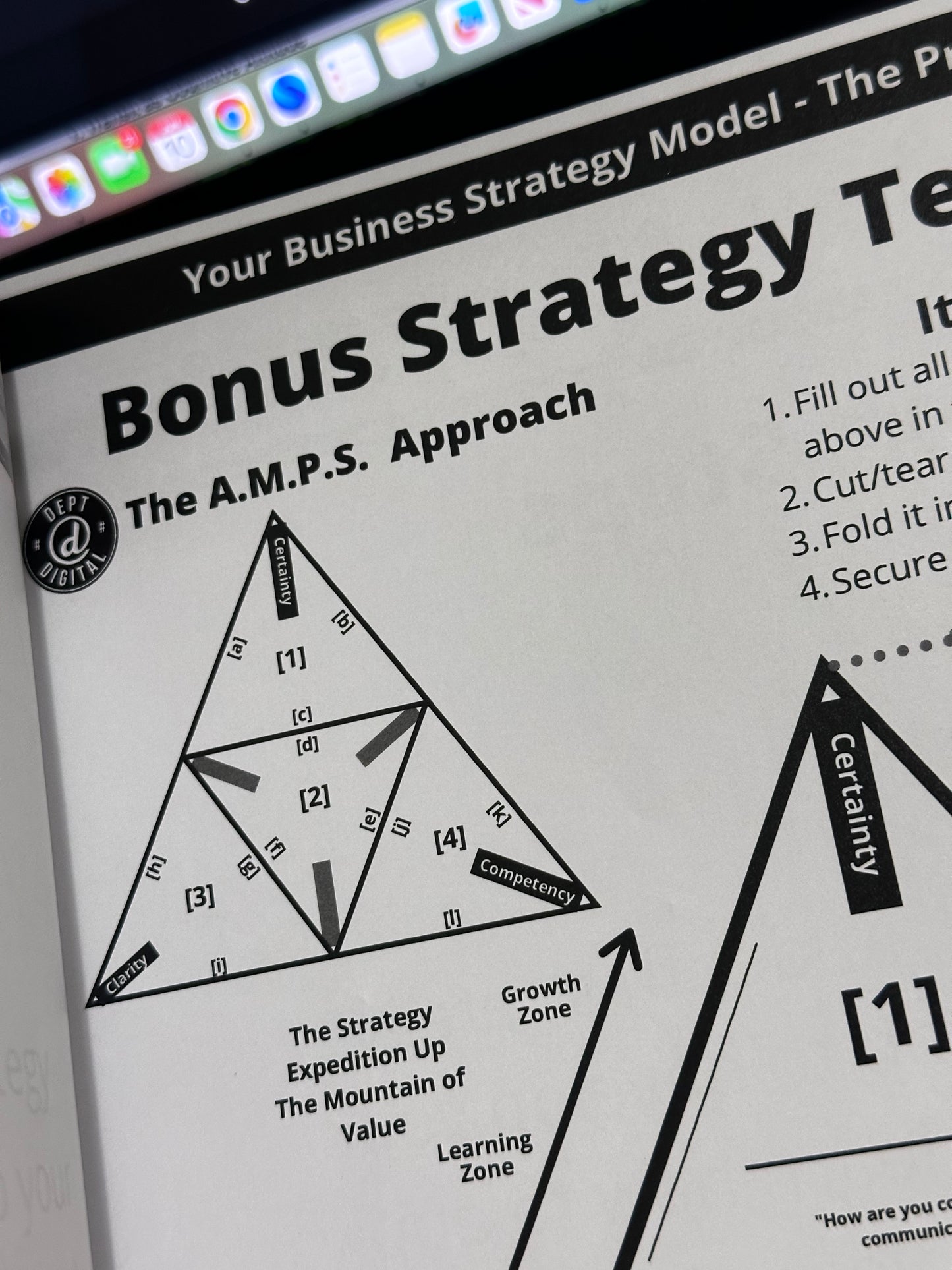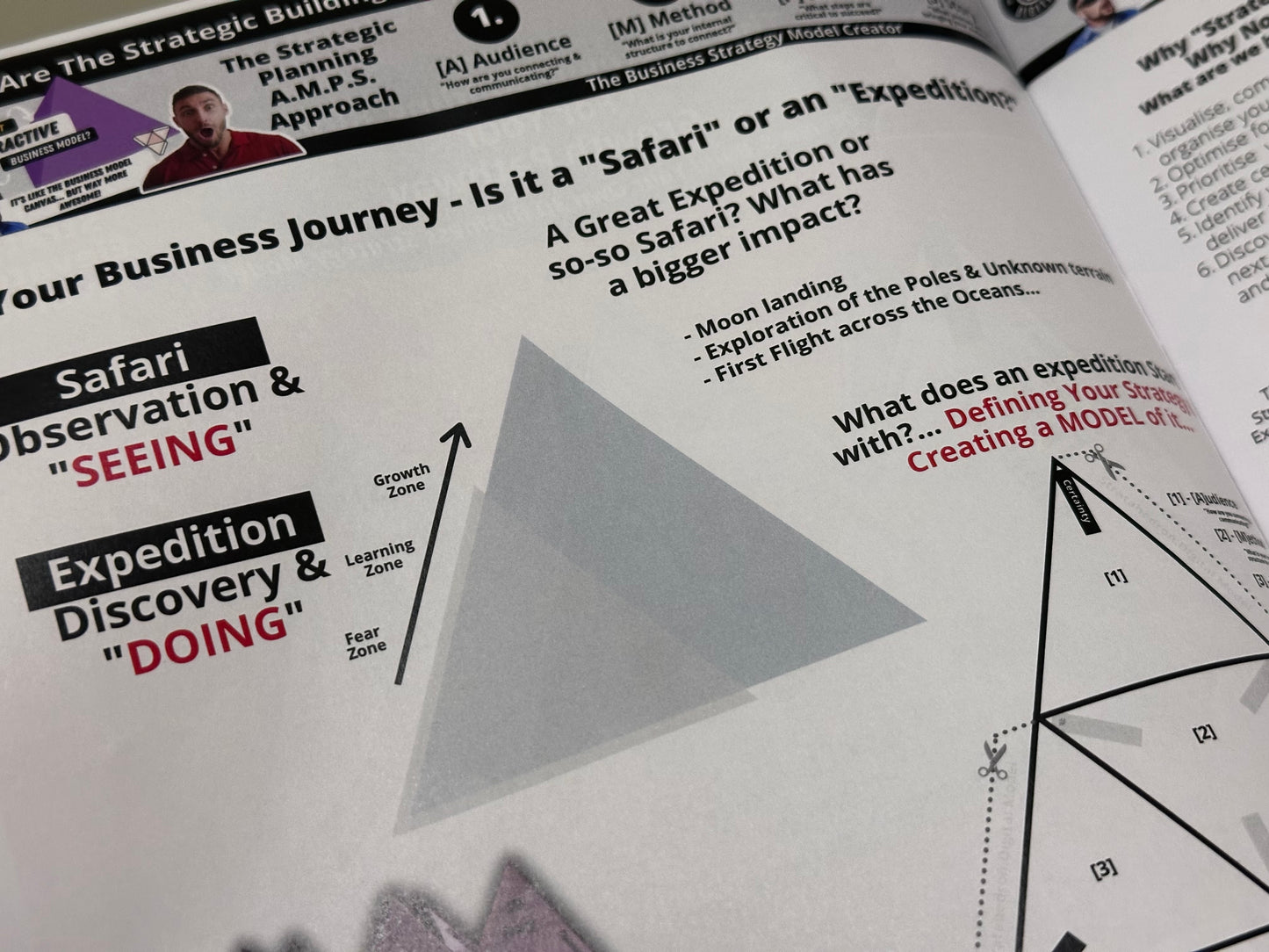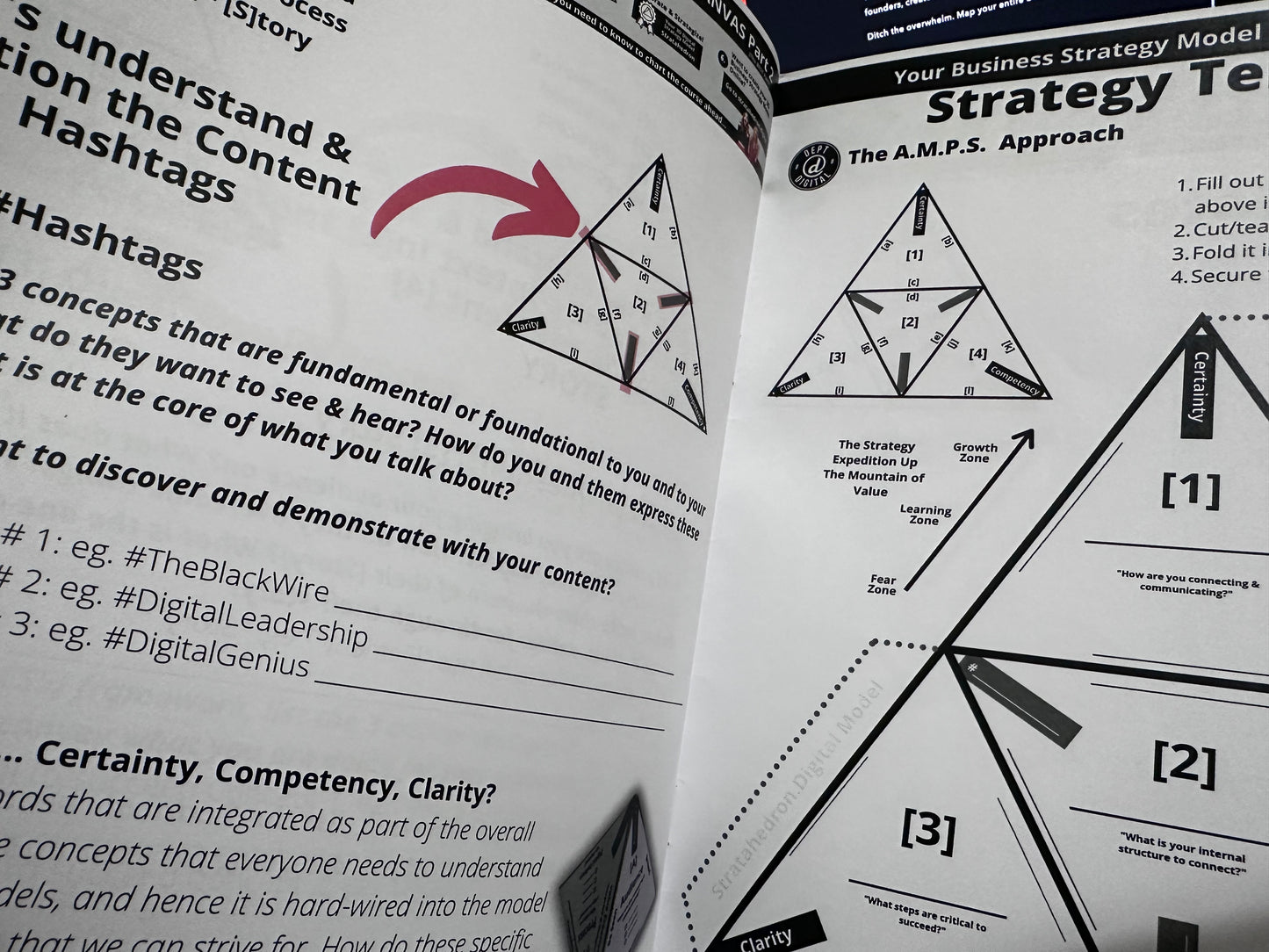
How to Use Strategy to Improve Innovation - Your Innovation Playbook
Share
Innovation is the key to staying ahead in today's competitive business landscape. Are you using it properly for Growth?
How do you ensure that your innovation efforts are focused and effective? The answer lies in strategic planning. By incorporating a well-defined strategy into your innovation process, you can maximize your chances of success and create a culture of innovation within your organization.
Understanding the Connection Between Strategy and Innovation
Before we dive into the specifics of how to use strategy to improve innovation, let's first explore the relationship between the two. Strategy, in the context of business, refers to the long-term plan that guides an organization in achieving its goals. It involves analyzing the current situation, setting goals, and determining the best course of action to achieve those goals. Strategy takes into account factors such as market conditions, competition, and available resources.
Innovation, on the other hand, involves the development and implementation of new ideas and solutions that create value. It is not just about coming up with new ideas; it's about implementing those ideas in a way that creates value. By constantly innovating, organizations can stay ahead of the competition, attract new customers, and even create new markets.
By aligning your innovation efforts with your business strategy, you ensure that your innovative ideas are not just random shots in the dark, but rather targeted solutions that address your organization's specific needs and goals. Having a well-defined strategy provides a roadmap for your innovation efforts. It helps you prioritize your resources, identify opportunities for innovation, and assess the potential risks and challenges that may arise along the way.
Get your Strategy Planning Checklist Here.
Defining Strategy in Business
To use strategy to improve innovation, it's important to have a clear understanding of what strategy entails. In business, strategy involves analyzing your current situation, setting goals, and determining the best course of action to achieve those goals. It takes into account factors such as market conditions, competition, and resources available.
Having a well-defined strategy provides a roadmap for your innovation efforts. It helps you prioritize your resources, identify opportunities for innovation, and assess the potential risks and challenges that may arise along the way. Strategy is not a one-size-fits-all approach; it needs to be tailored to the specific needs and goals of your organization.
When developing your strategy, it's important to involve key stakeholders from across your organization. This ensures that everyone is aligned and working towards a common goal. It also allows for diverse perspectives and ideas to be considered, which can lead to more innovative solutions.
The Role of Innovation in Growth
Now that we've explored the concept of strategy, let's delve into the role of innovation in driving growth. Innovation is not just about coming up with new ideas; it's about implementing those ideas in a way that creates value. By constantly innovating, organizations can stay ahead of the competition, attract new customers, and even create new markets.

When aligned with a well-defined strategy, innovation becomes a powerful tool for growth. It enables organizations to differentiate themselves from their competitors, improve their products and services, and find new ways to meet the evolving needs and expectations of their target audience.
Innovation can take many forms, from incremental improvements to radical breakthroughs. It can involve changes to products, processes, or business models. The key is to constantly challenge the status quo and look for opportunities to innovate.
Successful innovation requires a culture that encourages and rewards creativity and risk-taking. It requires a mindset that embraces change and sees failure as an opportunity to learn and improve. Organizations that foster a culture of innovation are more likely to succeed in today's fast-paced and ever-changing business environment.
Get your Strategy Planning Checklist Here.
The Importance of Strategic Planning for Innovation
Now that we understand the connection between strategy and innovation, let's explore why strategic planning is crucial for successful innovation.
In today's rapidly changing business landscape, innovation has become a key driver of growth and competitiveness. Organizations that fail to innovate risk being left behind by their competitors. However, innovation cannot happen in isolation. It needs to be guided by a strategic plan that aligns it with the overall goals and objectives of the organization.
Get your Strategy Planning Checklist Here.
Aligning Innovation with Business Goals
Strategic planning allows you to align your innovation efforts with your overall business goals. By clearly defining your goals and objectives, you can ensure that your innovation initiatives are focused and purposeful. This alignment ensures that your innovation efforts contribute directly to the growth and success of your organization.
For example, if one of your business goals is to increase market share, your strategic plan can guide your innovation efforts towards developing new products or services that will help you capture a larger share of the market. By aligning innovation with business goals, you can avoid wasting resources on ideas that do not contribute to the organization's strategic objectives.
Furthermore, strategic planning enables you to identify the areas in which innovation is most needed. It helps you identify gaps in the market or areas where your organization is falling behind its competitors. By focusing your innovation efforts on these areas, you can gain a competitive advantage and position your organization as a leader in the industry.
Prioritizing Innovation Initiatives
Strategic planning also helps in prioritizing your innovation initiatives. With limited resources, it is important to invest in projects that have the highest potential return on investment. By carefully assessing the potential impact and feasibility of each idea, you can allocate your resources effectively.

For instance, if you have multiple innovation ideas, strategic planning can help you evaluate each idea based on its potential market demand, technical feasibility, and financial viability. This evaluation process allows you to prioritize ideas that have the greatest potential for success and allocate resources accordingly.
Moreover, strategic planning helps you avoid the common pitfall of spreading your resources too thin. Without a strategic plan, it is easy to get caught up in the excitement of new ideas and start multiple projects simultaneously. However, this approach often leads to diluted efforts and limited results. By prioritizing innovation initiatives through strategic planning, you can focus your resources on a few key projects and increase the likelihood of their success.
Strategic planning is crucial for successful innovation. It aligns innovation with business goals, ensuring that your efforts contribute directly to the growth and success of your organization. It also helps in prioritizing innovation initiatives, enabling you to allocate resources effectively and increase the potential return on investment. By incorporating strategic planning into your innovation process, you can position your organization as a leader in the industry and drive sustainable growth.
Get your Strategy Planning Checklist Here.
Developing an Effective Innovation Strategy
Now that we understand the importance of strategic planning, let's explore how to develop an effective innovation strategy.
Identifying Opportunities for Innovation
Effective innovation starts with identifying opportunities for improvement and growth. This could involve analyzing market trends, conducting customer surveys, or brainstorming ideas with your team. By understanding the needs and desires of your target audience, you can uncover new opportunities and develop innovative solutions.
Setting Clear Innovation Objectives
Once you've identified opportunities for innovation, it's important to set clear objectives. Your objectives should be specific, measurable, achievable, relevant, and time-bound (SMART). They provide a clear direction for your innovation efforts and serve as a benchmark for measuring success.
Implementing Your Innovation Strategy
Now that you have a well-defined innovation strategy, it's time to put it into action.
Building a Culture of Innovation
A strong culture of innovation is essential for successful implementation of your strategy. Create an environment that encourages creativity, risk-taking, and collaboration. Foster a culture where employees feel empowered to share their ideas and experiment with new approaches. By nurturing a culture of innovation, you pave the way for the successful implementation of your strategy.
Monitoring and Adjusting Your Innovation Strategy
Implementing your innovation strategy is not a one-time event; it's an ongoing process. Regularly monitor your progress and adjust your strategy as needed. Seek feedback from your team and customers to ensure that your innovation efforts are on track. Adapt to changing market conditions and embrace new opportunities as they arise.
Get your Strategy Planning Checklist Here.
Overcoming Challenges in Strategic Innovation
While strategic innovation offers immense benefits, it also comes with its fair share of challenges. Let's explore how to overcome these challenges and ensure the success of your innovation efforts.
Dealing with Resistance to Change
Change can be met with resistance. When implementing your innovation strategy, expect pushback from those who are comfortable with the status quo. To overcome resistance, communicate the benefits of change, involve key stakeholders in the decision-making process, and provide training and support to help employees adapt to the new ways of doing things.
Ensuring Sustainability of Innovation Efforts
Innovation is not a one-time event; it's an ongoing journey. To ensure the sustainability of your innovation efforts, create a system for continuous improvement. Regularly review your innovation strategy, learn from both successes and failures, and implement mechanisms to capture and implement new ideas from your employees and customers.
How Do You Use Strategy To Improve Your Innovation Capabilities?
Using strategy to improve innovation is a powerful approach that enables organizations to stay ahead in an ever-changing business landscape. By aligning innovation with business goals, developing a clear strategy, and implementing it effectively, organizations can create a culture of innovation and drive growth. Overcoming challenges and adapting to change are essential for sustaining innovation efforts in the long run. So, embrace strategy, embrace innovation, and watch your organization thrive in the face of uncertainty.
Get your Strategy Planning Checklist Here.
Related Posts
-

How to Use Strategy to Improve Revenue: A Comprehensive Guide
Finding ways to improve revenue is essential & possible with Strategy
-
![The Entrepreneur Journey is Broken? [Part 1] - Strategystorming - The Strategy Studio & Shop for Strategic Thinkers](//strategystorming.co/cdn/shop/articles/the-entrepreneur-journey-is-broken-part-1-590109.webp?v=1701206679&width=170)
The Entrepreneur Journey is Broken? [Part 1]
What if the Entrepreneur Journey could be different?
-

Creating Certainty in an Uncertain Business Environment with The Business Design Strategy Sprint
-

How do you build a Strategy Operating System?
-

Business Strategy Mastery Workshop - Strategy Masterclass October 2022 Intake - Session Now Closed
Business Strategy Mastery Workshop - Strategy Masterclass October 2022 Intake Now Closed. It's time to rethink & reinvent how we think about strategy, but also how we understand, design, and create it. Get the thinking, tools, and know-how to craft business strategy like never before.
-

8 Simple Questions Every Strategy Must Answer to Be Able to See Your Greatest Competitive Advantage
Your biggest competitive advantage that you can ever have is how you think and how you problem solve better than anyone else, especially in these challenging times.
This is your strategic thinking, only you have it, and your future really does depend on it.
-

Is Business An Art Or More About Science? Hint: It's Neither
👉Being more clever
👉Being more creative
👉Being more skillful
👉Thinking more strategically
👉Reducing complex ideas & problems
👉Crafting uncommon solutions
👉Embracing complexity
-

Is Your Strategy Still Just a Pile of Notes and Guesswork?
The Creative Business Strategy Canvas™ is the clarity tool I built after hitting that wall one too many times.It’s one page. Visual. Brutal. Honest.
It shows you your business — as it actually is — so you can build what it’s meant to be.
-

Reinventing Rapid Business Growth With The Strategy SuperModels
Enter The World of Business Strategy SuperModels - Redefine and Reinvent
-

Unlock Business Growth with The Growth Pathway Strategy GPS SuperModel
Unlock Business Growth with The Growth Pathway Strategy GPS SuperModel
-

4 Strategic Steps to Rethink and Reimagine SWOT Analysis for Your Business
Here's How to Reimagine & Customize your SWOT with a Custom SWOT Analysis Worksheet
-

Reimagining & Reinventing Ikigai for Brand Strategy Design Consultants & Strategists
Exploring Brand Strategy Models & Case Studies In Strategy - The Reimagining of the Ikigai Model - The Strategy Super Model Series
-

Exploring Brand Strategy SuperModels & Case Studies in Strategy
-

FlightPath Day 80 of 100: Rhythm Over Hustle - How Founders don’t burn out from work
-

Want to Obtain Better Business Results in 4 Easy Steps? Keep it Simple - Here's A Really Simple Strategy With BIG Impact
-

10 Must-Haves to Master Your Digital Landscape - The Strategy Playbook
Transform Your Business Online With Clearcut Success Strategies In This Strategy Playbook
-

Do You Want to Lose Track of Your ‘Why’ & ‘How’ amongst all of the ‘WTFs’?
You’ll build out your business journey as your “FlightPath” with a close-knit group using the wisdom of your peers for reimagining your perspective, driving your OWN priorities & finding your OWN critical solutions.
-

How to Use Strategy to Improve Brand Awareness - The Brand Strategy Guide
Here's How to Use Strategy to Improve Your Brand Awareness
-

How to Use Strategy to Improve Market Share: What's Really Important?
How Do You Improve Market Share With Strategy?
-

How to Use Strategy to Improve Growth - A Definitive Guide
Strategy is an ongoing, dynamic process of Growth
-

10 Rules of a Strategy-Focussed Entrepreneur That Really Matter
What's really important for a strategy-focussed entrepreneur?
-

10 Rules That Really Matter for a Digital-Focussed Enterprise
Here's 10 simple rules to see if you are a digital-focussed business.
-

10 Invaluable Strategic Business Insights for Today’s Highly Competitive Business Environment.
10 invaluable insights for today’s highly competitive business environment using The Art of War
-

The Strategic Planning Success Blueprint: Navigating the Complex World of Planning With The Strategic Planning Checklist
-

The Annual Strategic Planning Panic Season Has Begun! Ditch the Drama, Embrace the Plan: Less Zigging, More Winning!
Strategic Planning Panic Season. Ditch the Drama, Embrace the Plan: Less Zigging, More Winning!
-

Unlock Your Business Brand Secrets: Master Your Brand & Strategy with the Strategystorming Sprint.
Don't let market disruptions steer you off course; take the helm of your business with unwavering confidence by mastering the art of strategic planning. This is your roadmap to not just surviving but thriving in today's volatile business landscape.
-

Can AI make you MORE Creative, Curious, Innovative AND more strategic? Yes or no?
Can AI make you MORE Creative, Curious, Innovative AND more strategic? Yes or no?
What if it could?
-

What You Think You Already May Know About Cognitive Biases...May Be Wrong
-

A Good Strategic Thinker And A BETTER Strategic Thinker - What's The Difference?
Improve your strategic thinking skills and increase your growth potential.
-

Good Strategy vs Bad Strategy. 5 Simple Symptoms To Identify a Really Bad Strategy.
What are the symptoms and signals that can help diagnose a potentially Good Strategy vs an ineffective Bad strategy?
-

Why Your Strategy Must Not Become A To Do List - The Only 5 Strategic Questions You Cannot Exist Without
By taking the time to answer these questions, you can develop a clear understanding of your company's purpose, its big idea, and how you're going to deliver value to your customers. This will help you to stay focused and on track as you build your business.
-

IMPACT: What would you actually do if you had more of it for your business?
Here's how to find and start to build your impact that lasts with digital strategy
-

The Business Top Gun's Playbook: Harnessing Speed of Strategy and Strategic Direction for Navigation for Impact
-

Which 4 Critical Components You Might Be Missing With Your Strategy - Here's How to Make Your Strategy Quicker, Cheaper & Easier
Is Your Strategy Too Hard? Here's How to Make Your Strategy easier to create, implement & execute without breaking a sweat
-

Strategystorming For Your Future: How Can Reinventing Strategy Help Future-Proof Your Business?
The Future May Be Uncertain, But You Don't Need To Be.
Strategystorming is a powerful tool for achieving success and creating a brighter future. By taking control of your destiny and developing effective strategies, you can overcome any obstacle and achieve your goals, no matter how big or small. -

The Power Of The Prompt - The Strategic Look At Artificial Intelligence Alignment & Business
-

Do You Have A Brand Plan? Here's how to Rethink & Stack the odds and start winning with a brand strategy
-

The 5 Key Strategic Factors You Need To Consider to Integrating AI into your Business Now. Here's How To Get Started to Integrate AI Effectively Into Your Business
5 Key Strategic Factors You Need To Consider In Integrating AI into your Business
What would happen if 80% of what you do is commoditized into the same thing that everyone else is doing? If you can no longer compete on price, and everything is now a commodity, what would you do? How can you accelerate your business while everything is accelerating around you?
-

What's Good Strategy or Bad Strategy? Fighting Fires Is No Longer a Startup Badge of Honour. We need to Reinvent How We Think About Strategy For Startups.
What's Good Strategy or Bad Strategy? Fighting Fires Is No Longer a Startup Badge of Honour. We need to Reinvent How We Think About Strategy For Startups and Smart Strategy for Business.
-

Sometimes we can be extremely surprised at how 'strategic' some things are when we compare it to other things. Here's a case in point.
Here's a case in point about how to get epic things done...strategically - without trying that hard.
-

Anyone can start a business, but can you finish one? Can you get yours to the finish line without a strategy?
Anyone can start a business, but it takes a special skill to finish one - strategy builds a business built to last. Are you building your business to last? It’s not a map, not a business model, not a SWOT, not a business plan, not a 1-page Marketing Plan; it's your strategy operating system that defines the difference.
-

Strategy is about change, and we are all architects of change with our strategic thinking
You're In The Business of Change. You Just Don't Know It...Yet.
What does it take to see Change?
How do we adapt change and think more strategically in the solutions that we deliver, and want to deliver?
-

Why being agile doesn’t save a small business? It’s more about your strategic thinking.
The solution to being agile is more about strategy and your strategic thinking ability
-

The Strategystorming Strategy Studio & Shop Launch Event Speakers Summary
It's strategic clarity & #certainty to help you know how to craft a better strategy, and use strategic & tactical tools for profitable growth and a superior ROI by leveraging the power of your brand.
-

The True Power of Reinvention for Business & Rethinking How We Create Remarkable, Winning Strategies - The Strategystorming Strategy Studio & Shop Launch
-

The Truth About What You Should Be Focussing More On in Your Business - Hint: It's 99% invisible
We don't investigate fully how our customers and audience are thinking - we simply gloss over what we think they need. We rarely feel that we 'need' a strategy to enhance what we're doing to drive profitability and how to win - or that it's something that only big companies have to do to please their corporate rulers. And, seldom do we use any systems to create better efficiencies.
-

How Easy Is It To Sacrifice Tomorrow for Today, Without Even Knowing It? Are You A Slave To The Now Because of Your Strategy in Business?
How Easy Is It To Sacrifice Tomorrow for Today, Without Even Knowing It? Are You A Slave To The Now Because of Your Strategy in Business?
-
![#SmartStrategy [Designing Your Strategy For Business] - Strategystorming - The Strategy Studio & Shop for Strategic Thinkers](//strategystorming.co/cdn/shop/articles/smartstrategy-designing-your-strategy-for-business-256943.jpg?v=1693515536&width=170)
#SmartStrategy [Designing Your Strategy For Business]
Strategy is often what you need to do, but also what you don't need to do. It tells you what you see, but also what you don’t see.
-

Is Bigger All There Is in Business? What does the word GROWTH actually mean for GROWING a business?
If only we could grow more, if only we could scale more, if only we could...
-

Is 'Bigger' All There Is? Reinventing & Rethinking Your Business With Strategy
Strategystorming is the new thinking place where we become better strategic thinkers, by applying strategy here and now, sharing what strategy is for business, and how best to realise it and craft it into remarkable experiences.
-

Do You Know The Biggest Reasons Why a Business Fails? It's Not Because of Tech & Creativity
Why does a business fail, and what can you do about it?
Planning & #strategy is not a "to-do list"
It's not even a list of goals you want to achieve, or "what do you want to become in 2022?" (are you a flower? 😂)
-

What will it take for things to return to business as usual?
It's not business as usual anymore. The Easy Strategy Lab is where we find out how to Reinvent & Reimagine & Rethink business.
We are back with a Strategystorming Show on the 4 greatest myths about strategy, change & reinvention - the misconceptions and outdated assumptions that might be killing your efforts or the efforts of your clients today.
-

Strategy Expeditions for Reinvention, Growth & Performance by Strategystorming - The Strategy Mastery Training Course Workshop
What's Creative Intelligence & Strategic Innovation?Learning strategy and implementation with creative tools and storytelling.Unleash the potential within your business or clients to solve your unique business challenges and create dynamic resilient futures.Meet our Creative Intelligence and Strategic Innovation course - Strategy Mastery Training.
It's education, but not as you know it.
It's a workshop Expedition - a Strategy Expedition to get you to your destination... and back, learning, creating, understanding and crafting your ultimate strategy of resilience & success.

![The Entrepreneur Journey is Broken? [Part 1] - Strategystorming - The Strategy Studio & Shop for Strategic Thinkers](http://strategystorming.co/cdn/shop/articles/the-entrepreneur-journey-is-broken-part-1-590109.webp?v=1701206679&width=170)













































![#SmartStrategy [Designing Your Strategy For Business] - Strategystorming - The Strategy Studio & Shop for Strategic Thinkers](http://strategystorming.co/cdn/shop/articles/smartstrategy-designing-your-strategy-for-business-256943.jpg?v=1693515536&width=170)




